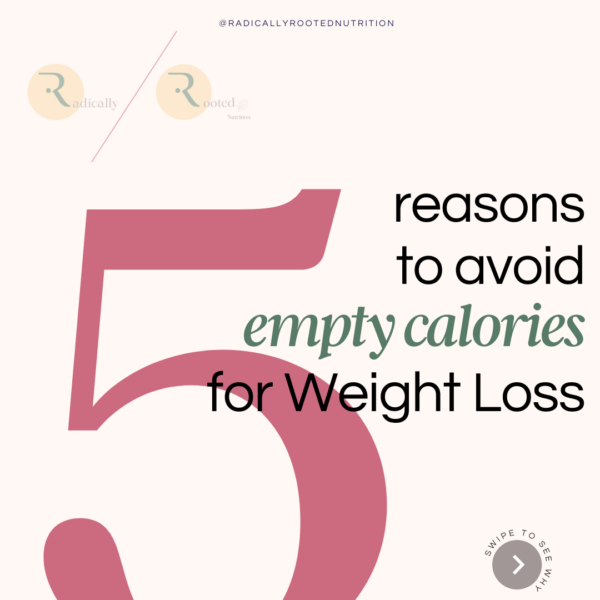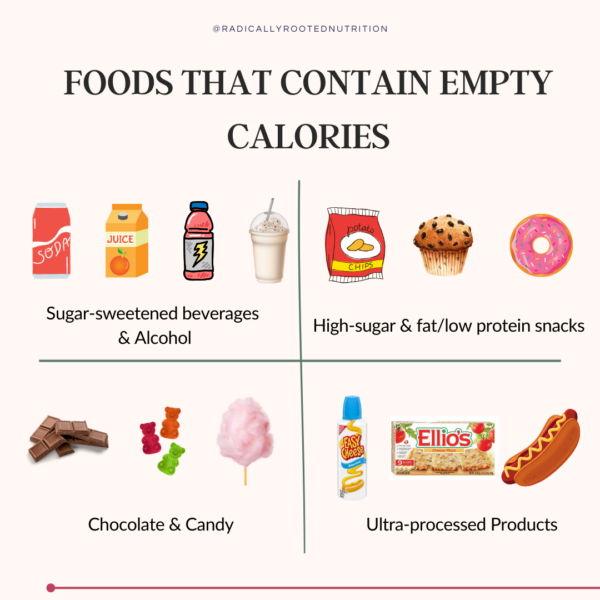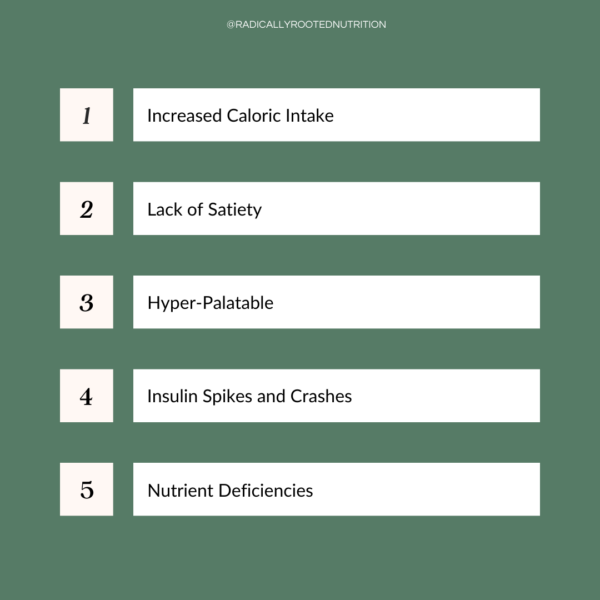5 Reasons to Avoid Empty Calories for Weight Loss
When speaking to clients about weight loss, I often emphasize meals and foods that leave them satisfied and full. These meals and foods are large in volume, are nutrient-dense, and low in calories. That almost sounds too good to be true but it is mostly certainly not. We should steer clear of consuming foods that are high in “empty” calories, as they do not provide any significant nutritional value other than calories and carbohydrates. So what are empty calories and why should we avoid them if we are trying to lose weight and be healthier overall? Let’s talk about it.

WHAT ARE EMPTY CALORIES?
The term “empty calories” is commonly thrown around when we are learning about eating healthy; however, it has no true scientific definition. Generally speaking, the term empty calories refers to foods that have little to no nutritional value. Empty-calorie foods are typically high in calories from added sugar, fat, and/or alcohol, and contain limited amounts of protein, fiber, good fats, vitamins, and minerals.
However, it’s important to understand that although they are referred to as empty calories that does not mean they do not contain any nutrients. They just contain a lot of one or two nutrients that oftentimes reap little to no benefit to our bodies. These foods are often made up of solid fat and added sugar.
- Solid fats- fats that are solid at room temperature, like butter, beef fat, and shortening. Some solid fats are found naturally in foods. They can also be added when foods are processed by food companies or when they are prepared.
- Added sugars- sugars and syrups that are added when foods or beverages are processed or prepared.
- High Carbohydrate low fat and protein foods.
Examples of foods that contain empty calories:
- Refined sugars and syrups,
- Soft drinks, energy drinks, fruit juice with added sugar, fruit drinks, and other sugar-sweetened beverages,
- Bagels, pretzels, white bread, pasta, white rice
- Milkshakes and sugary coffee drinks, such as Frappucinos,
- Solid fats, such as shortening,
- Alcohol, including beer, wine, and spirits,
- Candy and chocolate bars,
- Pastries, such as cookies, cakes, and donuts,
- Ultra-processed dairy products, such as American cheese slices and Cheese Whiz,
- Ultra-processed meats, such as hot dogs,
- Ultra-processed grain products, such as sugary cereals and potato chips.
- Sausages, hot dogs, bacon, and ribs

5 Reasons to Avoid Empty Calories for Weight Loss
While they are called ‘empty’ calories, calories are a measure of energy, and they are a sum of the energy provided in grams by the three macronutrients in our diet: carbohydrates, proteins, fats and alcohol. Carbohydrates contain 4 calories per gram. Protein contains 4 calories per gram, fat contains 9 calories per gram and alcohol contains 7 calories per gram. For example, if a chocolate chip cookie contains 20g of carbohydrates, 4g of protein and 7g of fat, 20g carbs x 4 calories = 80; 4g protein x 4 calories = 16; 7g fat x 9 calories = 63. This totals 80 + 16 + 63= 159 calories in 1 cookie. While it is very clear that any item that has calories contains macronutrients as well as energy, that does not mean that they contain additional vitamins and minerals that contribute to our health. Let’s take a look at how these foods can affect weight loss…
1- Increased Caloric Intake
Foods with empty calories often pack a lot of calories into small serving sizes, which can lead to overconsumption of calories without providing the feeling of fullness. This can make it easy to exceed daily calorie needs, leading to weight gain rather than weight loss.
2- Lack of Satiety
Since these foods lack fiber, protein, and other essential nutrients that promote satiety, they can leave you feeling hungry soon after eating. This can result in snacking on more empty-calorie foods, further contributing to excess calorie intake.
3- Hyper-Palatable
Empty calories tend to be found in ultra-processed foods, and ultra-processed foods are designed to the hyper-palatable. Food manufacturers design hyper-palatable foods to have specific combinations of fat, sugar, sodium, and carbohydrates – such as potato chips – that make them artificially rewarding to eat and harder to stop consuming. So, not only are empty-calorie foods lower in nutrients and higher in calories but they are easier to over-consume compared to nutrient-dense whole foods.

4- Insulin Spikes and Crashes
Foods high in added sugars can cause rapid spikes in blood sugar levels, leading to a subsequent crash. This rollercoaster effect can increase hunger and cravings, making it harder to stick to a calorie-controlled diet.
5- Nutrient Deficiencies
Relying on foods with empty calories can lead to deficiencies in essential nutrients. When your body lacks these nutrients, it can affect metabolism and energy levels, potentially slowing down weight loss efforts.
Is Weight Loss Possible with Consuming Empty Calories?
Weight loss all comes down to calories in and calories out. It is not possible to overcome the concept of thermodynamics. If you were to eat a cookie that is 250 calories and that is the only thing you ate all day, absolutely you would lose weight but you are also depriving yourself of healthy nutrients your body needs to survive. Not to mention, eating just a cookie all day seems pretty unrealistic to me…
Identifying Empty Calorie Foods
As noted above, food contains calories and no foods are truly empty of calories, however, some foods (especially ultra-processed foods) are less nutrient-dense than others, and reading food labels can help you determine this. Here is what to look for:
- Foods low in essential nutrients. Look at the nutrition facts label and refer to the column of % of Daily Value. Nutrient-dense food will have higher percentages, while foods with low nutrient density will have a small percentage or zeros.
- Foods high in added sugar. Read the ingredient list and look for sources of added sugar and refer to the nutrition facts labels to see exactly how much added sugar the food contains per serving.
- Foods low in fiber. Look at the nutrition facts label and refer to the number of grams of fiber the food contains per serving. Foods high in carbohydrates and high in sugar but low in fiber are typically less nutrient-dense options.
Foods to Focus On Instead
When it comes to calories, food quality is important. To ensure that you’re reaching your calorie intake and consuming adequate nutrients, it’s best to prioritize whole foods in the form of fruits, vegetables, nuts, seeds, whole grains, beans, lentils, meat, seafood, eggs, and dairy. The nutrient-rich nature of these foods ensures that they are filling, satiating, and nourishing at the same time, which overall supports weight loss.
Bottom Line
Empty calories are calories that contain little to no nutritional value. Empty-calorie foods are foods that contain far more calories from fat, sugar and carbohydrates than other valuable nutrients. For weight loss success, it is best to prioritize nutrient-dense whole foods in the diet and keep empty-calorie foods to a minimum.



